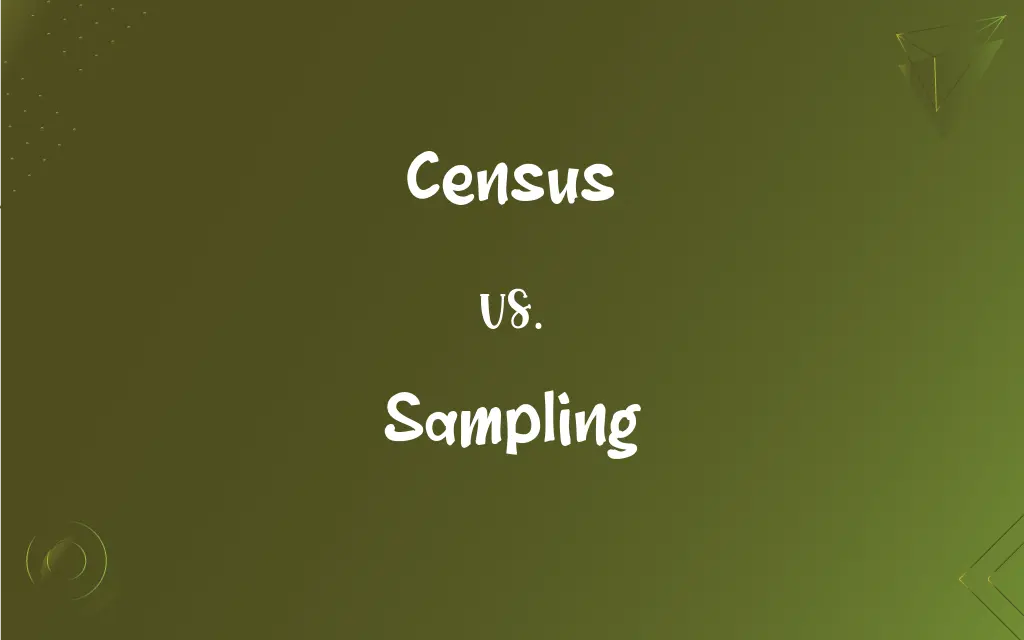Census vs. Sampling: What's the Difference?
Edited by Aimie Carlson || By Harlon Moss || Updated on October 10, 2023
A census collects data from every individual in a population, while sampling collects data from a subset of that population.

Key Differences
Census and sampling constitute two primary methodologies in collecting data for research and statistical analysis, each holding distinct merits and demerits depending on the study's context and objectives. In a census, every single member of the population under study is measured or surveyed, allowing for an exhaustive collection of data that provides a comprehensive view of the population. In contrast, sampling involves the selection and study of a subset or sample of the population, which, if properly selected, aims to representatively portray the broader population. While a census can offer exact and complete data, sampling strategically allows for insights about a larger group by examining a strategically selected subset, balancing accuracy with feasibility.
The inherent costs and logistical demands associated with the application of census and sampling methods underscore substantial differences in their practical implementation. A census, by virtue of involving the entire population, often demands significant resources, time, and energy, especially in scenarios where the population is large and geographically dispersed. On the other hand, sampling, by limiting the study to a select group, can drastically reduce costs and time commitments, although the precision of the data can be influenced by the effectiveness of the sampling strategy and size, balancing financial and temporal considerations with data reliability and accuracy.
In terms of data accuracy and reliability, census and sampling offer divergent potentials and challenges that need meticulous consideration in research design. A well-conducted census theoretically presents a high level of accuracy since it accounts for every individual or unit within the population, minimizing the potential for sampling error. However, sampling, while inherently susceptible to sampling errors and biases if the sample is not truly representative of the population, provides the opportunity to invest more resources per unit studied, which can, in certain contexts, actually enhance the quality and depth of the data obtained, offering insights that might be impractical to pursue within the scope of a full census.
Analyzing the flexibility and applicability of census and sampling methods reveals the distinct scenarios and contexts where each might be preferable or feasible. For populations that are relatively small, homogenous, or when precise data is imperative for decision-making, a census may be the appropriate methodology. Conversely, when dealing with large populations, or when time and resources are limited, sampling may provide a viable and efficient alternative, capable of yielding sufficiently accurate and insightful data to inform decisions and understandings, tailoring the method to the practical and informational needs of the study.
Lastly, ethical and pragmatic considerations also play pivotal roles in determining whether a census or sampling method should be employed in a particular study. In certain instances, a census might be deemed necessary due to legal or policy mandates, ensuring equitable consideration of all population units, especially in contexts such as national population censuses. Alternatively, sampling might be particularly pertinent in scenarios where the study involves a level of risk or burden to participants, thereby limiting potential negative impacts to a smaller, volunteer subset of the population, safeguarding ethical standards while still facilitating valuable research. Both methodologies, when judiciously chosen and meticulously applied, hold the power to furnish invaluable data, informing understandings and guiding decision-making across varied domains.
ADVERTISEMENT
Comparison Chart
Definition
Complete count of all individuals
Selecting a subset of individuals
Scope
Entire population
Part of the population
Accuracy
Exact
Estimate, with some margin of error
Cost & Time
Typically more costly & time-consuming
Less costly & faster, depending on design
Purpose
Comprehensive data collection
Inference based on subset
ADVERTISEMENT
Census and Sampling Definitions
Census
An official count or survey, especially of a population.
The census data helps in the allocation of resources.
Sampling
The selection of a fraction of the whole to infer about the entire group.
Random sampling helps in reducing selection errors.
Census
An exhaustive gathering of statistical data.
The national census provided insights into demographics and employment.
Sampling
Taking a portion from a larger whole for analysis.
Sampling the water from various parts of the river indicated changing pollution levels.
Census
A complete enumeration of a population.
The government conducts a census every ten years to count the population.
Sampling
A technique used to gather representative data or observations.
Sampling techniques must be chosen wisely to avoid bias.
Census
A collection of data on all units of interest.
The plant census revealed the number of each species in the region.
Sampling
The process of selecting a subset of a population for study.
Through sampling, researchers can make inferences about the larger group.
Census
A systematic acquisition of detailed information about every member in a group.
The library's book census ensures every book is accounted for.
Sampling
A method to understand characteristics of a larger population.
Sampling revealed that 60% of the town preferred the new policy.
Census
An official, usually periodic enumeration of a population, often including the collection of related demographic information.
Sampling
(Statistics) See sample.
Sampling
The act, process, or technique of selecting an appropriate sample.
FAQs
Why is a census conducted?
A census provides comprehensive data about an entire population, which aids in decision-making and resource allocation.
What are the advantages of sampling?
Sampling can be quicker, less expensive, and more feasible than a census in many situations.
Why might one choose sampling over a census?
Sampling can be chosen for reasons like cost-effectiveness, feasibility, or when speed is a priority.
How often is a national census typically conducted?
Most countries conduct a national census every 10 years.
Can census results influence political decisions?
Yes, census data can influence political decisions, like redistricting.
How does sampling differ from a census?
Sampling selects a subset of the population, whereas a census covers the entire population.
Can sampling results be as accurate as a census?
Sampling can provide accurate estimates with a known margin of error, but it's based on probability and not an exact count like a census.
What are common sampling methods?
Common methods include random sampling, stratified sampling, and cluster sampling.
How are sampling sizes determined?
Sampling sizes are determined based on desired accuracy, population size, and variability.
Is census data public?
Typically, aggregated census data is public, but personal identifying details remain confidential.
What is a census?
A census is a complete count of every individual in a specified population.
Can a census have errors?
Yes, a census can have errors due to factors like non-responses or miscounting.
Why is the design of sampling important?
The design affects the accuracy and reliability of the results and inferences made about the whole population.
How comprehensive is census data?
Census data is comprehensive, covering every individual in the specified population.
What is the main goal of sampling?
The main goal of sampling is to gather information about a larger population using a representative subset.
What factors can influence the accuracy of sampling?
Sample size, method of selection, and potential biases can influence accuracy.
How do governments use census data?
Governments use census data for policymaking, resource allocation, and demographic analysis.
What's the primary challenge with a census?
The primary challenge with a census is its scale, which can make it costly and time-consuming.
Can sampling be used in conjunction with a census?
Yes, sampling can complement a census, especially for more detailed studies on specific subgroups.
Is sampling always random?
No, there are both random and non-random sampling methods.
About Author
Written by
Harlon MossHarlon is a seasoned quality moderator and accomplished content writer for Difference Wiki. An alumnus of the prestigious University of California, he earned his degree in Computer Science. Leveraging his academic background, Harlon brings a meticulous and informed perspective to his work, ensuring content accuracy and excellence.
Edited by
Aimie CarlsonAimie Carlson, holding a master's degree in English literature, is a fervent English language enthusiast. She lends her writing talents to Difference Wiki, a prominent website that specializes in comparisons, offering readers insightful analyses that both captivate and inform.































































